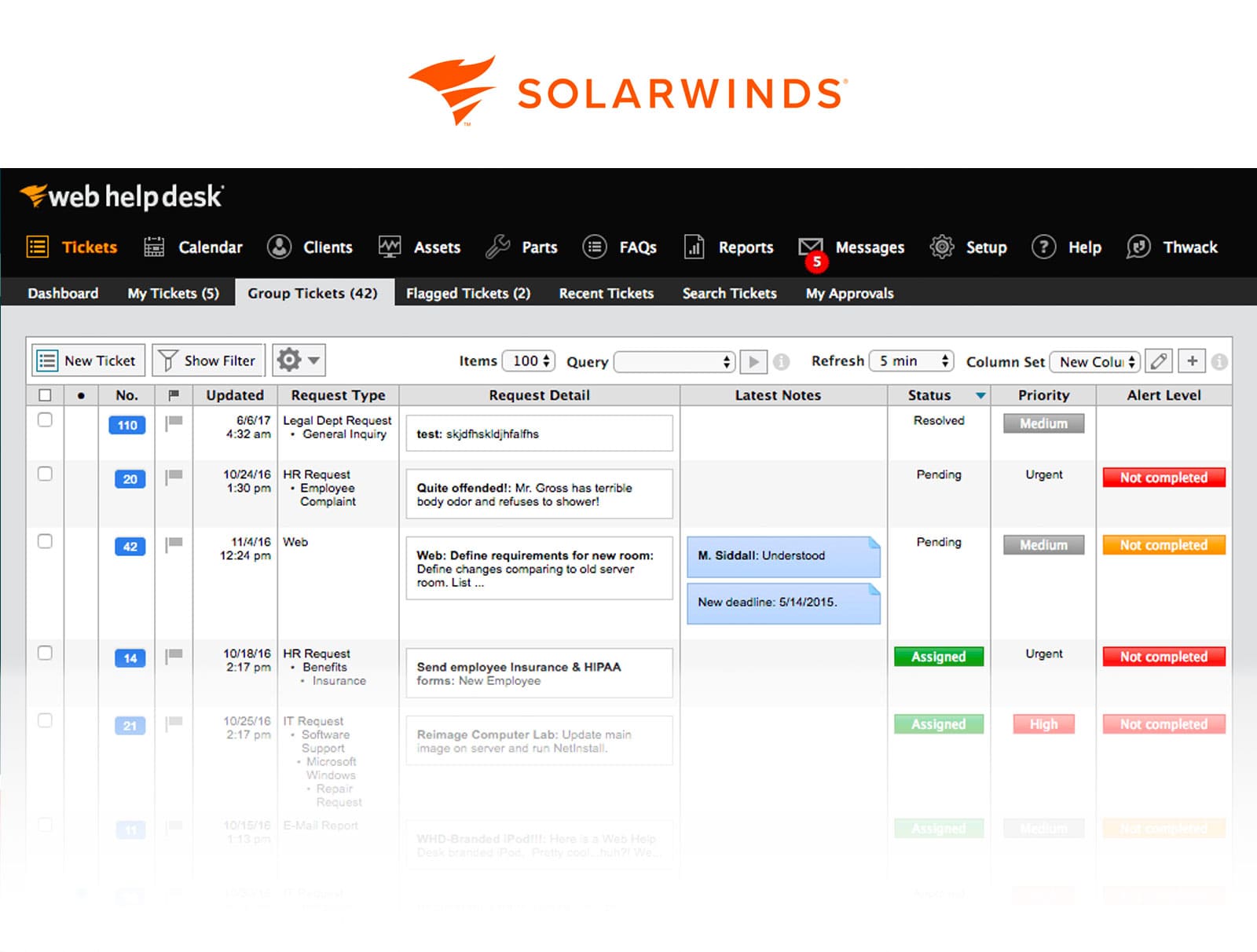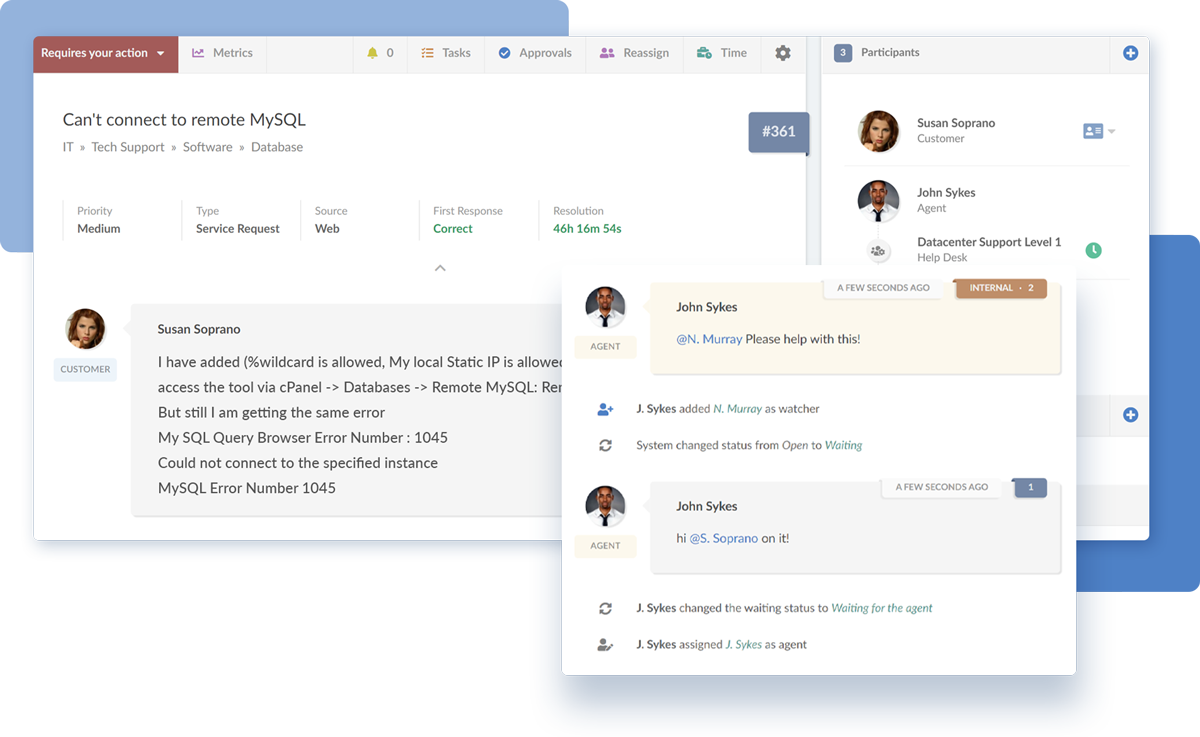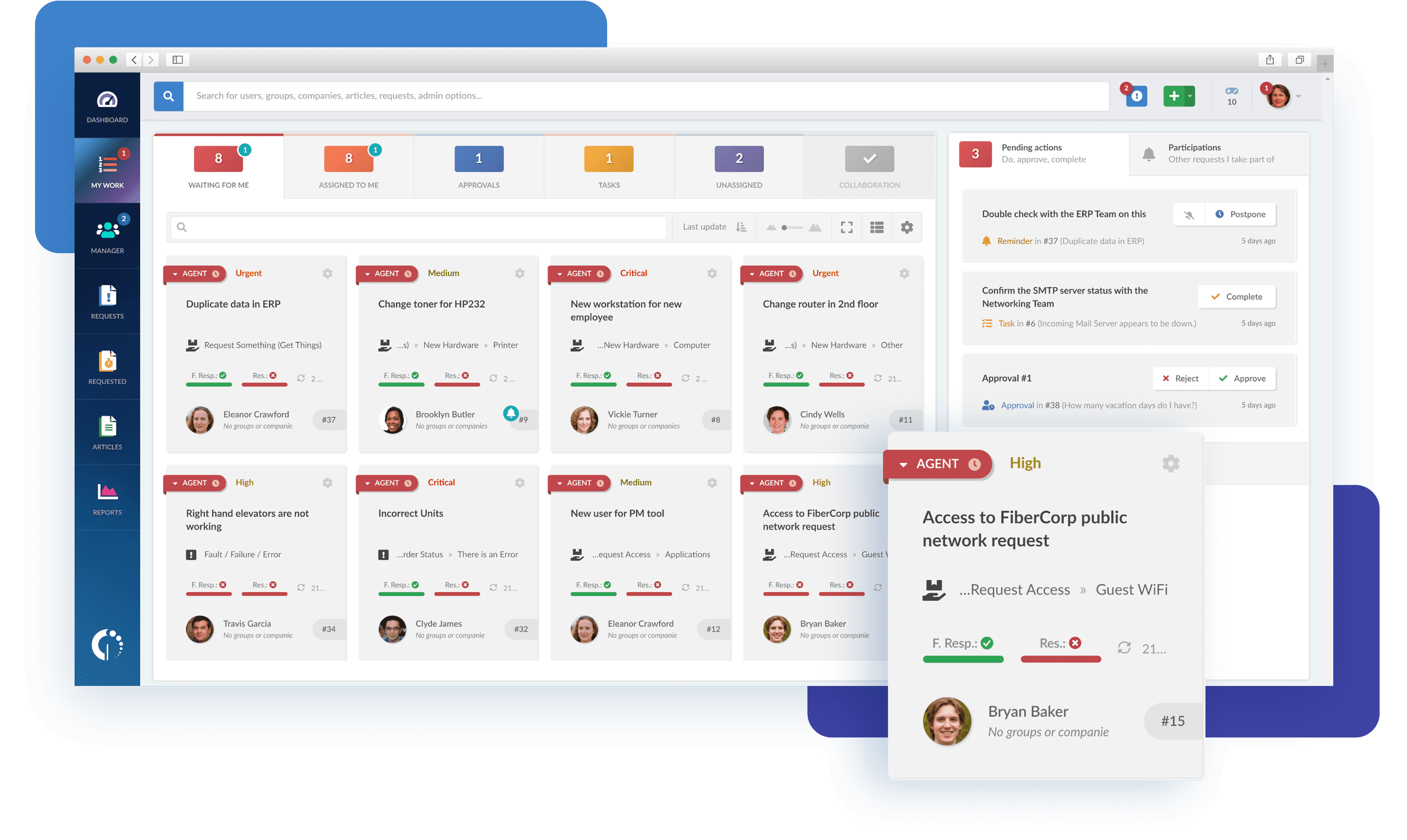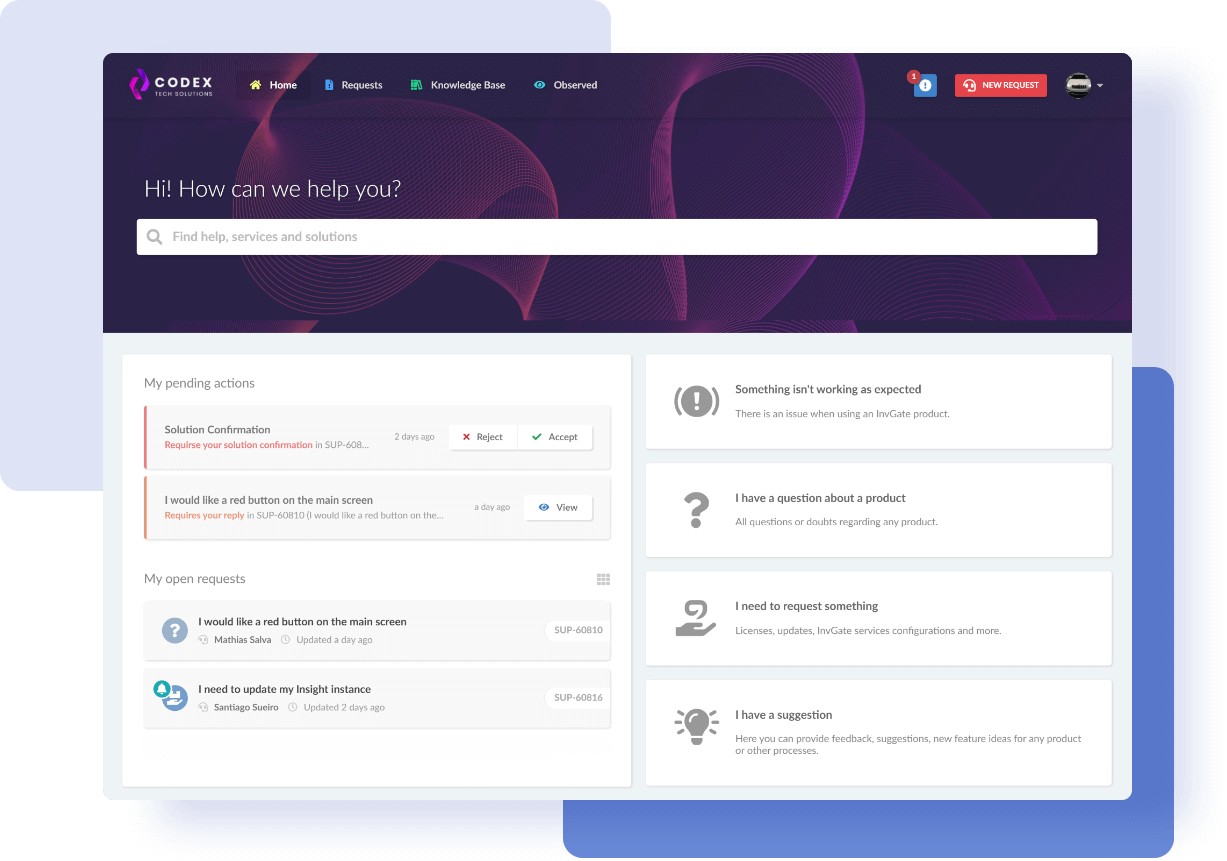When it comes to selecting the ideal IT Service Management (ITSM) solution for your organization, the choice between SolarWinds vs. Jira Service Management can be a tough one. Both platforms offer compelling features and capabilities, but how do they truly measure up against each other? Which one aligns best with your organization's unique requirements? And what if there's a third alternative that outshines them both?
In this blog post, we’ll embark on a comprehensive comparison of SolarWinds and Jira Service Management, dissecting their core features, strengths, and weaknesses.
But an eye-catching alternative emerges amidst the competition between these prominent contenders - InvGate Service Management. With its streamlined functionalities and a strong emphasis on digital transformation, this service desk software presents organizations with a distinctive opportunity to take their IT operations to new heights.
Let's dive into this in-depth ITSM tool comparison and discover the perfect fit for your organization's IT Service Management needs.

Table of contents
- TL;DR
- What is SolarWinds?
- What is Jira Service Management?
- Considering InvGate Service Management as an ITSM solution alternative
TL;DR
- SolarWinds Service Desk excels in ITSM features, user interface, customization, and efficiency benefits, users have faced challenges with initial setup, third-party integration, complex workflows, and report generation.
- Jira Service Management is praised for its sprint planning, task assignment, ticketing system, and user-friendly portal. However, some users are unhappy with the migration process, reporting options, learning curve, and reliance on plugins.
- InvGate Service Management revolutionizes ITSM with versatile deployment options, robust ticketing and incident management, and intuitive self-service. It empowers organizations to optimize IT operations and deliver exceptional service.
We tried to be as thorough as possible, but if you don't have enough time to read it through and through, here's (another) TL;DR: InvGate Service Management can do everything we say here, and you can test it right away for free for 30 days.
Most looked-at features by buyers
When potential buyers evaluate IT Service Management solutions, they focus on specific features that align with their organization's needs. Understanding these desired features is crucial for making well-informed decisions.
Let's explore the key factors that potential buyers commonly consider when comparing ITSM tools.
- Ticket Management solution - Buyers emphasize the importance of a comprehensive Ticket Management System within the help desk software. This feature enables effective tracking, assignment, and resolution of customer inquiries and support requests.
- Efficient IT Asset Management - Users prioritize software that offers robust ITAM capabilities to help them maintain accurate inventories and optimize resource utilization within their organizations.
- User experience and interface - Buyers value ease of use and interface design. They prefer a user-friendly platform with an intuitive interface that promotes user adoption and productivity. Mobile accessibility is also important for organizations with remote or mobile workforces.
- Customization and flexibility - Buyers value software solutions that offer customization options, allowing them to customize the platform to their business needs. This flexibility ensures the software aligns with their unique workflows and processes, enhancing user satisfaction and overall effectiveness.
- Support automation and Workflow Management - Buyers actively seek software solutions that offer automation capabilities to optimize routine tasks such as ticket routing, approvals, and escalations. These automation features contribute to increased efficiency and productivity.
- Insightful reporting - Buyers look for help desk software with powerful reporting tools like dashboards and reports, providing valuable insights into their IT operations and performance. This data-driven approach facilitates informed decision-making and continuous service improvement.
- Seamless integration capabilities - Integration with other systems and applications is a critical requirement for buyers, ensuring smooth data flow and process automation. The ability to integrate existing tools and platforms is highly valued for improved efficiency and a unified user experience.
- Optimized IT service catalog - Organizations often require a streamlined IT service catalog, providing a centralized platform for users to request specific IT services or resources. This feature simplifies service requests, enhances visibility, and aids in effective service delivery management.
- Self-service portal and knowledge base - Including a self-service portal is highly valued as it empowers end-users to independently resolve common issues and find relevant information without requiring direct assistance.
- Scalability - Organizations with changing needs prioritize solutions that can adapt to their growth and accommodate customization. The solution should allow the creation of custom fields, workflows, and extensions/plugins, enabling them to tailor the software to their unique business requirements.
- Pricing and support - Buyers consider the cost-effectiveness of the solution, including licensing models, subscription plans, and additional costs for features or users. The availability of reliable customer support, comprehensive documentation, and accessible training resources also play a significant role in the decision-making process.
- ITIL compliance - Adhering to ITIL best practices is a priority for many organizations. Buyers may prioritize solutions that support ITIL processes, such as Incident Management, Problem Management, Change Management, and Asset Management.
What is SolarWinds?

SolarWinds Corporation is a company that specializes in developing software solutions for managing IT systems. One of their main products is SolarWinds Service Desk, a cloud-based platform designed to support IT Service Management. This platform offers various features and functions to improve the efficiency and productivity of IT operations.
These features include automation capabilities, self-service options, tools for managing IT assets, and seamless integration with other systems. The platform is structured into modules that handle incidents, problems, releases, and changes, and it also includes a Configuration Management Database (CMDB). Users have the ability to generate customized reports that provide valuable insights into their operations.
What users like from SolarWinds
SolarWinds Service Desk has received positive feedback from users, as evidenced by reviews from Gartner. Let's explore the advantages that both customers and experts have highlighted.
- Comprehensive ITSM features - Users appreciate the platform's wide range of features, including Incident Management, Problem Management, Change Management, Asset Management, and a service catalog. The platform is highly regarded for its comprehensive set of capabilities.
- User-friendly interface and experience - Users consistently commend the platform's intuitive navigation. This makes it easily accessible and user-friendly for individuals with varying levels of technical expertise.
- Customization and integration options - Users value the available customization options that allow them to tailor the platform to their specific needs. They also appreciate its integration capabilities with other tools and services.
- Effective IT Asset Management - Users highly value the software's ITAM capabilities, which enable efficient tracking of hardware, software, licenses, and contracts.
- Improved efficiency and productivity - Users report significant improvements in efficiency and productivity through streamlined IT operations and effective incident resolution processes facilitated by the software.
What users don’t like from SolarWinds
Despite its strengths, SolarWinds Service Desk has received some criticism from customers, as documented in reputable sources like Gartner. Let's explore some of the concerns that have been raised.
- Limited customization options - Users have mentioned that the available customization options are limited and could benefit from expansion.
- A desire for additional features - Users desire other features, such as a calendar booking system, webhooks for integration purposes, and enhanced functionality on the mobile app.
- Complex workflow - Users find the workflow within the software difficult or cumbersome, indicating a need for simplified processes.
- Limitations in reporting functionality - Users desire improved reporting capabilities and more comprehensive analytics within the software.
- Challenges in initial setup and implementation - Some users find the initial setup and implementation process time-consuming, especially when importing existing inventory.
- Integration with third-party apps - Users feel the platform could improve its seamless integration with third-party applications.
- Localization and language support - Some users suggest that the platform could enhance support for multiple languages and improve localization features to cater to a more diverse user base.
- Limitations in search functionality - Users have noted limitations in the search functionality of the tool, suggesting a need for improvements in this area.
What’s SolarWinds’ argument over Jira Service Management?
When comparing SolarWinds and Jira Service Management, both platforms offer compelling features and have their unique strengths and weaknesses. Let's explore SolarWinds' argument over Jira Service Management, highlighting the advantages it brings to the table.
- Comprehensive ITSM features - Users appreciate the platform's wide range of capabilities, including Incident Management, Problem Management, Change Management, Asset Management, and a service catalog. It provides organizations with a comprehensive set of tools to manage their IT services effectively.
- User-friendly interface and experience - SolarWinds Service Desk offers an intuitive navigation system that is easily accessible and user-friendly for individuals with varying levels of technical expertise. The platform's user-friendly design promotes ease of use and contributes to a seamless user experience.
- Customization and integration options - Users value the available customization options that allow them to tailor the platform to their specific needs. SolarWinds Service Desk also offers integration capabilities with other tools and services, enhancing its versatility and adaptability.
- Effective IT Asset Management - SolarWinds Service Desk is highly regarded for its IT Asset Management capabilities. It enables efficient tracking of hardware, software, licenses, and contracts, providing organizations with a comprehensive view of their IT ecosystem.
- Improved efficiency and productivity - Users report significant improvements in efficiency and productivity through streamlined IT operations and effective incident resolution processes facilitated by SolarWinds Service Desk. The platform empowers IT teams to work more efficiently and deliver better service to their organizations.
What is Jira Service Management?

Jira Service Management, a product developed by Atlassian, is a specialized platform designed for IT Service Management. It provides organizations with an efficient solution for streamlining their service desk operations. With its robust features and user-friendly interface, Jira Service Management empowers businesses to optimize their service delivery and enhance customer satisfaction. Currently, it offers a cloud-based service option, allowing organizations to leverage the benefits of cloud computing for their Service Management needs.
Atlassian, the company behind Jira, was founded in 2002 by Mike Cannon-Brookes and Scott Farquhar in Sydney, Australia. Since its establishment, the company has experienced significant growth and expanded its global presence by establishing offices in various countries, including the United States, Netherlands, Japan, and the Philippines.
Atlassian specializes in developing software and tools tailored specifically for developers and project managers. Their extensive product portfolio includes well-known offerings like Confluence, Bitbucket, and Trello, which have gained widespread recognition in the industry. These versatile tools cater to a range of requirements, covering areas such as project management, issue tracking, content collaboration, code management, and team facilitation.
What users like from Jira Service Management
Analysis from reputable sources like Gartner and G2 indicates positive feedback from Jira Service Management users. Here are some of the key benefits that have been acknowledged.
- Intuitive and user-friendly interface - Users highly appreciate the platform's user-friendly interface, which improves incident and request management. The design promotes ease of use, enabling teams to navigate and interact with the system effortlessly.
- Efficient ticketing system with customizable workflows - Jira Service Management's ticketing system and customizable workflows simplify task management. It enables teams to track and prioritize tickets according to their specific needs.
- Simplified sprint planning and task assignment - The platform seamlessly integrates with popular collaboration platforms like Slack and Teams, streamlining sprint planning and task assignment. The Kanban view serves as a centralized hub for managing tasks, while the tagging function allows for efficiently organizing project-specific tasks.
- Comprehensive task details and robust filtering capabilities - Users value complete task details as they provide in-depth information about each task. This feature allows teams to have a holistic understanding of their work. Additionally, the platform offers powerful filtering capabilities, allowing users to search, sort, and organize tasks based on specific criteria, ultimately enhancing productivity.
- Improved user portal for self-service and feedback - The platform includes an enhanced user portal that facilitates self-service for users. It allows users to independently assess incidents and requests, empowering them to resolve issues whenever possible independently. Users can also provide feedback on the overall process after issue resolution, contributing to continuous improvement and customer satisfaction efforts.
- Flexible pricing options - Jira Service Management offers a range of flexible pricing options to accommodate organizations of different sizes and budgets. This includes a free plan suitable for small teams of up to three users with 2 GB of storage. The cloud-hosted option provides a reasonably priced base package.
What users don’t like from Jira Service Management
Despite its many strengths, Jira Service Management is not without customer concerns and dislikes. Analysis from sources like Gartner and G2 has revealed recurring criticisms from users.
- Limitations in task tracking and reporting - Users have experienced challenges in tracking multiple tasks, generating comprehensive reports, and creating customized dashboards within the platform. These limitations can hinder users' ability to monitor and effectively analyze project progress and performance.
- Challenging migration process - Users have raised concerns about the complexity of transitioning to Jira Service Management's projects. Some users have encountered difficulties that may require a separate user subscription, making the migration process cumbersome.
- Steep learning curve - The platform's robust capabilities and extensive functionalities can result in a steep learning curve for users. Some individuals may require additional guidance or training to navigate and utilize the system and its features effectively.
- Limited and complex integrations - Users have expressed a desire for more readily available integrations and have had to develop custom solutions to connect Jira Service Management with specific tools. Integrating the platform with external systems can be challenging and time-consuming.
- Reliance on additional plugins - Users have expressed the need to rely on additional plugins to access basic features within the system. Additionally, complying with data protection regulations like GDPR has posed challenges for some users.
- Less intuitive interface - Compared to alternative options, some users find Jira Service Management's interface less intuitive, particularly when external customers interact with the platform.
- Issues with Atlassian support - Users have reported challenges when seeking assistance from Atlassian support. They have faced difficulties in obtaining the necessary support and guidance, which can impact their overall experience.
What’s Jira Service Management’s argument over SolarWinds?
Jira Service Management presents a compelling case against SolarWinds, offering its unique advantages and addressing some of the concerns users raise. Let's delve into Jira Service Management's argument over SolarWinds, highlighting its strengths.
- Efficient ticketing system with customizable workflows - Jira Service Management's ticketing system and customizable workflows simplify task management. It allows teams to track and prioritize tickets according to their specific needs, enhancing their ability to manage and resolve incidents effectively.
- Simplified sprint planning and task assignment - The platform seamlessly integrates with popular collaboration platforms like Slack and Teams, streamlining sprint planning and task assignment.
- Comprehensive task details and robust filtering capabilities - Jira Service Management provides complete task details, offering in-depth information about each task. This feature allows teams to have a holistic understanding of their work. Additionally, the platform offers powerful filtering capabilities, enabling users to search, sort, and organize tasks based on specific criteria, ultimately enhancing productivity.
- Improved user portal for self-service and feedback - Jira Service Management includes an enhanced user portal that facilitates self-service for users. It empowers users to independently assess incidents and requests, enabling them to resolve issues whenever possible. Users can also provide feedback on the overall process after issue resolution, contributing to continuous improvement and customer satisfaction efforts.
Considering InvGate Service Management as an ITSM solution alternative
Although SolarWinds and Jira Service Management are well-known competitors in the ITSM industry, exploring alternative solutions that closely match your organization's specific requirements is crucial. In this context, InvGate Service Management emerges as a compelling option worth careful consideration.
Let's delve into the advantageous features of InvGate Service Management that make it an invaluable choice for addressing your ITSM needs.
ITIL best practice compliance
InvGate Service Management has earned the prestigious PinkVERIFIED Certified certification,, demonstrating its commitment to upholding ITSM excellence. Whether organizations are starting their ITIL journey or managing complex operations, InvGate Service Management offers a user-friendly and feature-rich experience aligned with industry best practices.
Robust Ticketing and Incident Management
InvGate Service Management excels in providing powerful features for Ticketing and Incident Management. It enables efficient tracking, collaboration, and resolution of tickets, empowering IT teams to handle and prioritize incidents effectively. Automated ticket routing, customizable workflows, and SLA Management enhance the efficiency of incident resolution processes.

Designed for ITSM and ESM
InvGate Service Management is purpose-built for ITSM while seamlessly extending its capabilities to Enterprise Service Management (ESM). It empowers operational departments to enhance their processes and fully embrace digital transformation benefits, promoting streamlined workflows and comprehensive digital initiatives across all departments.
Comprehensive Asset Management
By integrating InvGate Service Management with InvGate Asset Management, organizations gain a holistic view of their IT ecosystem, leading to improved service delivery and reduced downtime. InvGate Asset Management offers features like IT Asset Discovery, Inventory Management, Software License Management, and maintenance schedules.

Simplified configuration and setup
InvGate Service Management streamlines the configuration and setup process with a no-code/low-code approach. This simplifies the system's implementation, enabling users of varying technical expertise to adopt it easily. The platform offers straightforward configuration options that quickly leverage its robust ITSM capabilities.
Outstanding user experience
InvGate Service Management prioritizes delivering an exceptional user experience through meticulous design and adherence to UI/UX best practices. Its intuitive interface promotes quick adoption and reduces the need for extensive training, ensuring a user-friendly design that maximizes productivity.

Customization and flexibility
InvGate Service Management offers flexible deployment options, allowing organizations to choose between on-premise or cloud-based solutions. This adaptability ensures that the platform can cater to the specific requirements of different sectors and industries.
Extensive reporting and analytics
InvGate Service Management provides comprehensive reporting and analytics functionalities, offering valuable insights into IT operations and performance. The platform includes ready-to-use reports and customizable dashboards, enabling IT teams to analyze data, identify patterns, and make informed decisions to enhance their services.

Robust self-service capabilities
InvGate Service Management offers a user-friendly portal, an extensive IT service catalog, and a knowledge base, empowering end-users to independently resolve common issues, access IT services, and utilize self-help resources. This reduces the burden on IT staff.

Cost-effective solution
InvGate Service Management provides a cost-effective solution without compromising functionality. It offers a comprehensive range of ITSM features at a competitive price, making it an appealing choice for organizations seeking affordability without sacrificing capabilities. Compared to alternatives like SolarWinds and Jira Service Management, InvGate Service Management strikes a balance between cost and functionality.
Fast ROI and ongoing innovation
InvGate Service Management ensures a fast Return On Investment through efficient implementation processes. Within weeks, organizations can begin experiencing the benefits of this robust ITSM solution. Additionally, regular feature updates keep users at the forefront of technology without incurring additional costs.
Next steps
As you navigate the complex IT Service Management solutions landscape, the choice between SolarWinds vs. Jira Service Management may seem daunting. However, there is a compelling alternative that stands out: InvGate Service Management. With its streamlined functionalities and unwavering commitment to digital transformation, this platform presents a unique opportunity for organizations to optimize their IT operations and drive overall efficiency.
Don't just take our word for it—experience the power of InvGate Service Management for yourself through our live demo. Take the first step today and unlock the full potential of your organization with InvGate Service Management.
















